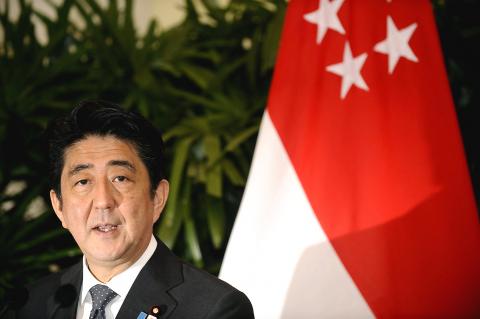Japanese Prime Minister Shinzo Abe yesterday called for a leaders’ summit or a foreign ministers’ meeting between his country and China as soon as possible, drawing a cool reaction from Beijing, which accused Japan of lacking sincerity.
Sino-Japanese ties, often fragile, have been seriously strained since September when a territorial row flared over tiny islands in the East China Sea which Taiwan also claims. Concerns that the conservative Japanese leader wants to recast Japan’s wartime history with a less apologetic tone have added to the tensions.
“I think there should be a summit meeting and also a foreign ministers meeting as soon as possible ... I think such meetings should be held without pre-conditions,” Abe said in response to a question at an academic conference in Singapore.

Photo: Reuters
China’s Ministry of Foreign Affairs said its door was always open for talks, but that the problem lay in Japan’s attitude.
“The crux of the matter at present is Japan’s unwillingness to face up to the serious problems which exist in Sino-Japan relations, and it is avoiding having earnest talks and consultations with China,” the ministry said in a statement faxed to Reuters.
Japan, it said, should “stop using empty slogans about so-called dialogue to gloss over disagreements.”
Earlier yesterday, the Japanese Defense Ministry issued a policy report repeating Japanese concerns about China’s military build-up and its activities near the islands.
The Chinese Foreign Ministry said it hoped Japan would respect the concerns of neighboring countries and “take the path of peaceful development and not artificially create and exaggerate tensions.”
The policy report called for an increase in the country’s military capabilities and a more assertive role in regional security due to increased threats from China and North Korea.
If implemented, some of the changes outlined by the interim Defense Ministry paper would be a major shift in policy for a military that is currently limited to self-defense and is banned from operating in overseas combat zones under a pacifist constitution.
The paper said Japan should increase its surveillance capability and consider using drones, or unmanned surveillance vehicles, capable of wide-range, high-altitude monitoring around the clock.
The paper also proposed creating a marine force with amphibious functions to defend disputed islands in the East China Sea. It said the Japan-US security alliance remains “the cornerstone” of Japan’s defense policy and urged Japan to step up its ability to respond to ballistic missile attacks amid concerns about North Korea’s nuclear and missile development.
A final report is expected at the end of this year.
On Friday, four ships from China’s newly formed civilian coast guard entered what Japan considers its territorial waters near the Diaoyutai Islands (釣魚台), known in Japan as the Senkaku Islands and as the Diaoyu (釣魚) in China, but left the area later without incident.
Abe also met with US Vice President Joe Biden in Singapore, after which the US restated its wish for tensions to subside.

The US government has signed defense cooperation agreements with Japan and the Philippines to boost the deterrence capabilities of countries in the first island chain, a report by the National Security Bureau (NSB) showed. The main countries on the first island chain include the two nations and Taiwan. The bureau is to present the report at a meeting of the legislature’s Foreign Affairs and National Defense Committee tomorrow. The US military has deployed Typhon missile systems to Japan’s Yamaguchi Prefecture and Zambales province in the Philippines during their joint military exercises. It has also installed NMESIS anti-ship systems in Japan’s Okinawa

‘WIN-WIN’: The Philippines, and central and eastern European countries are important potential drone cooperation partners, Minister of Foreign Affairs Lin Chia-lung said Minister of Foreign Affairs Lin Chia-lung (林佳龍) in an interview published yesterday confirmed that there are joint ventures between Taiwan and Poland in the drone industry. Lin made the remark in an exclusive interview with the Chinese-language Liberty Times (the Taipei Times’ sister paper). The government-backed Taiwan Excellence Drone International Business Opportunities Alliance and the Polish Chamber of Unmanned Systems on Wednesday last week signed a memorandum of understanding in Poland to develop a “non-China” supply chain for drones and work together on key technologies. Asked if Taiwan prioritized Poland among central and eastern European countries in drone collaboration, Lin

NO CONFIDENCE MOTION? The premier said that being toppled by the legislature for defending the Constitution would be a democratic badge of honor for him Premier Cho Jung-tai (卓榮泰) yesterday announced that the Cabinet would not countersign the amendments to the local revenue-sharing law passed by the Legislative Yuan last month. Cho said the decision not to countersign the amendments to the Act Governing the Allocation of Government Revenues and Expenditures (財政收支劃分法) was made in accordance with the Constitution. “The decision aims to safeguard our Constitution,” he said. The Constitution stipulates the president shall, in accordance with law, promulgate laws and issue mandates with the countersignature of the head of the Executive Yuan, or with the countersignatures of both the head of the Executive Yuan and ministers or

CABINET APPROVAL: People seeking assisted reproduction must be assessed to determine whether they would be adequate parents, the planned changes say Proposed amendments to the Assisted Reproduction Act (人工生殖法) advanced yesterday by the Executive Yuan would grant married lesbian couples and single women access to legal assisted reproductive services. The proposed revisions are “based on the fundamental principle of respecting women’s reproductive autonomy,” Cabinet spokesperson Michelle Lee (李慧芝) quoted Vice Premier Cheng Li-chiun (鄭麗君), who presided over a Cabinet meeting earlier yesterday, as saying at the briefing. The draft amendment would be submitted to the legislature for review. The Ministry of Health and Welfare, which proposed the amendments, said that experts on children’s rights, gender equality, law and medicine attended cross-disciplinary meetings, adding that